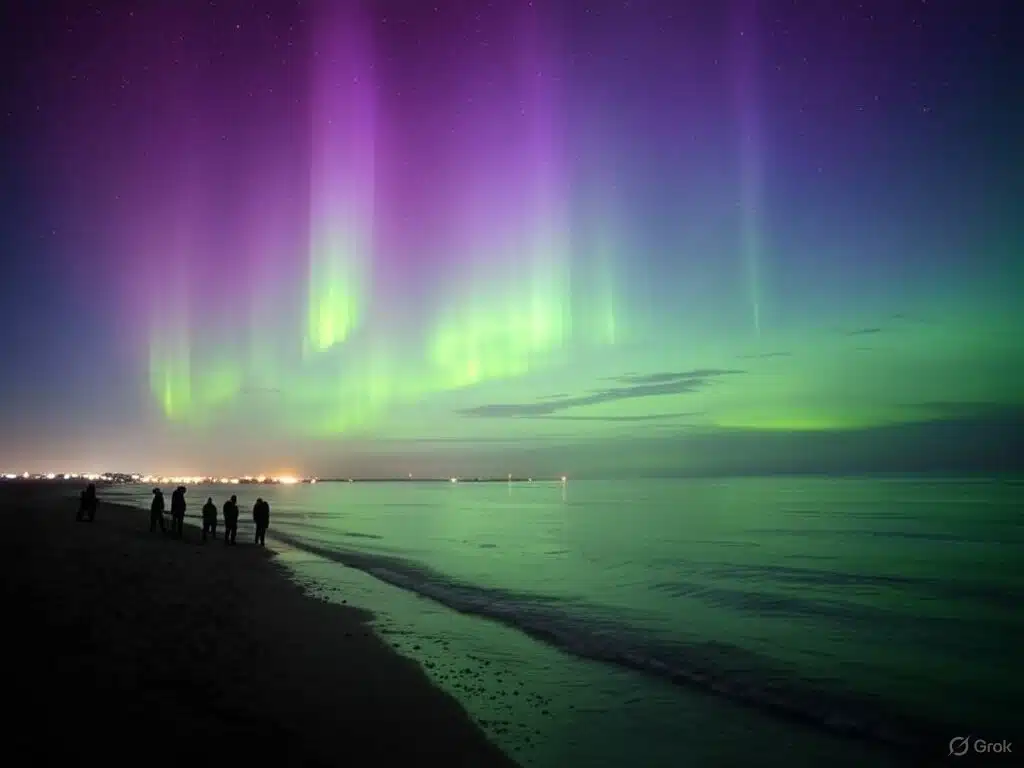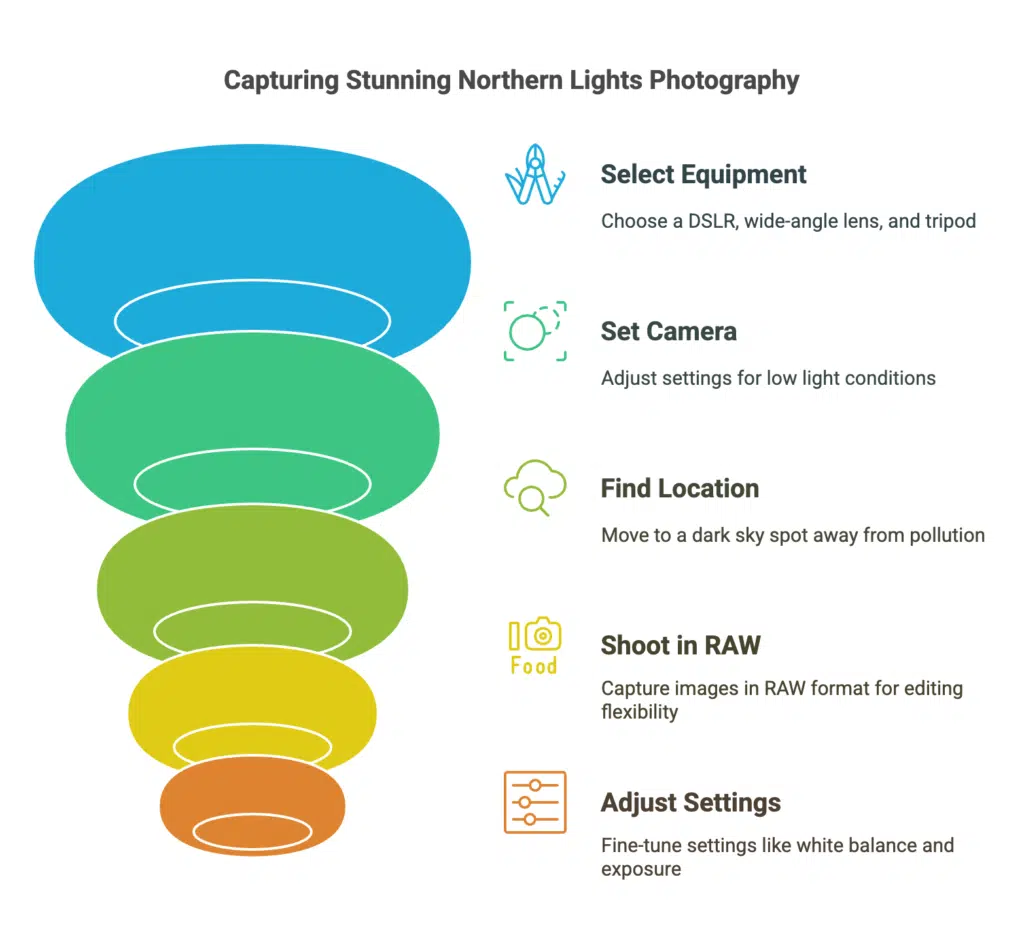Have you ever stepped outside on a chilly night and looked up to see the sky glowing in green and purple? It might remind you of Norway or Iceland. But you can actually see the Northern Lights right here in Germany.
Many people think you have to travel to the Arctic Circle to see the Northern Lights. However, Germany has recently experienced some beautiful light displays because of new solar activity.
So, where can you see them? When is the best time? And how can you boost your chances of catching this rare sight? That’s precisely what we’re going to explore in this guide. Let’s get started!
Northern Lights in Germany
Interest in seeing the Northern Lights has grown among people in Germany, both locals and visitors. Under the right conditions—like strong solar activity and clear, dark skies—some northern regions offer a chance to witness this stunning natural display without leaving the country. Whether you love stargazing or want a magical night outdoors, this guide will help you find the best places, useful tips, and conditions for viewing the Northern Lights in Germany.
The Northern Lights, or Aurora Borealis, are a natural light display that occurs when charged particles from the sun collide with gases in Earth’s atmosphere. These interactions create glowing waves of colour, illuminating the night sky, often appearing in shades of green, purple, blue, and red.
The Science Behind the Northern Lights

The sun sends many tiny particles toward Earth every day. About 1.5 million solar particles reach our planet daily. Earth’s magnetic field pulls these particles toward the poles. Near the poles, particles hit gases in Earth’s atmosphere. This collision creates beautiful lights called auroras.
- Green – Produced by oxygen at lower altitudes (most common).
- Red – Created by oxygen at higher altitudes.
- Blue & Purple – Formed when nitrogen reacts with charged particles.
Where and When to See Auroras: Auroras often happen near Earth’s magnetic poles. 70% of auroras appear around these polar areas. 86% of the time, you see auroras best in clear, dark skies.
Causes of the Northern Lights:
- Solar winds hit Earth’s atmosphere.
- Collisions produce bright and colourful lights.
- Earth’s ozone layer also affects how clear auroras appear.
Why Are the Northern Lights Mostly Seen in Polar Regions?
The Earth’s magnetic field directs most solar particles toward the North and South Poles, creating auroral zones around these areas. This is why countries like Norway, Sweden, Finland, and Canada are well-known for their Northern Lights displays. However, during periods of high solar activity, the aurora can be visible in locations further south—including parts of Germany.
Best Locations in Germany to View the Northern Lights
Seeing the Northern Lights in Germany is rare but possible, especially during periods of intense solar activity. The best chances are in the northern regions, where city lights make the skies darker and less polluted. Here are some of the best locations to witness this natural wonder:

1. Schleswig-Holstein
Germany’s northernmost state offers some of the best conditions for spotting the Northern Lights in Germany. The flat landscapes and open skies create ideal viewing opportunities, especially in rural areas away from city lights.
Top spots:
- Nordfriesland – Coastal areas near the Danish border have reported aurora sightings.
- Wadden Sea National Park – A UNESCO-listed area with minimal light pollution.
The North Sea Coast
The coastal regions of Lower Saxony and Schleswig-Holstein provide clear, dark skies, especially on remote islands.
Top spots:
- Sylt – A popular island with broad horizons and low light pollution.
- Amrum – A small island with vast beaches and dark skies.
- Heligoland – A secluded island far from city lights, perfect for sky-watching.
3. Rügen Island (Mecklenburg-Vorpommern)
Located in the Baltic Sea, Rügen is one of Germany’s darkest places, making it an excellent spot for stargazing. The island has reported sightings of the Northern Lights in Germany during intense geomagnetic storms.
Top spots:
- Jasmund National Park – Offers stunning coastal views and clear skies.
- Cape Arkona – A northernmost point with wide, open horizons.
4. Harz National Park (Lower Saxony & Saxony-Anhalt)
Further south, this mountainous region has minimal light pollution at higher altitudes. During peak solar activity, the aurora has been spotted here.
Top spots:
- Brocken Mountain – The highest peak in northern Germany, offering clear night skies.
- Mecklenburg Lake District – A rural area with vast open skies.
- Uckermark Region (Brandenburg) – Known for its dark sky parks, which improve visibility.
Note: While Germany isn’t a top aurora destination, visiting these locations during high solar activity and clear winter nights increases the chances of seeing the Northern Lights.
Frequency of Northern Lights in Germany Over the Past Year
In 2024, Germany was treated to some amazing displays of the Northern Lights thanks to heightened solar activity. The most impressive show happened on October 10, 2024, when a powerful storm from the sun allowed people in areas like Kiel, near the Baltic Sea, to see the beautiful auroras dancing in the sky.

On March 24, 2024, residents of Bremen were treated to a mesmerizing 12-minute display of the northern lights, also known as auroras. This event shows that even people living in cities can get lucky and see this beautiful phenomenon.
The rise in aurora sightings in Germany is linked to the sun’s 11-year cycle, which is currently reaching a peak. During this time, more frequent and stronger magnetic storms can create these stunning light displays in the sky.
These magical events have drawn the attention of both locals and visitors, turning spontaneous aurora sightings into shared experiences for everyone to enjoy. This has sparked a growing interest in watching the night sky across the country.
Predictions for 2025: Northern Lights Activity in Germany
Due to heightened solar activity, the Northern Lights are expected to be more visible in Germany in 2025. This increase in visibility is linked to the sun nearing the peak of its 11-year solar cycle, known as the solar maximum, which is anticipated to occur around July 2025.
Understanding the Solar Cycle
The solar cycle is an approximately 11-year cycle during which the sun’s activity fluctuates between low and high periods. During the solar maximum, the sun exhibits increased phenomena such as sunspots and solar flares. These events release charged particles into space, and when they interact with Earth’s magnetic field, they can produce the mesmerizing displays known as auroras.
Implications for Aurora Viewing in Germany
As the solar maximum intensifies, the auroral oval expands around the poles where auroras are most frequently observed. This expansion increases the likelihood of auroral displays at lower latitudes, including regions like Germany. Therefore, during intense solar activity in 2025, residents and visitors in northern Germany may have enhanced opportunities to witness the Northern Lights.
To maximize the chances of observing the aurora, enthusiasts should seek out dark-sky locations with minimal light pollution, especially during the equinoxes in March and September, when auroral activity often peaks.
Tips for Planning Your Northern Lights Adventure
Seeing the Northern Lights in Germany requires careful planning, as sightings depend on solar activity, weather conditions, and dark skies. Here are some practical tips to improve your chances of witnessing this rare phenomenon.
- 1. Choose the Right Time of the Year
- The best months for Northern Lights in Germany are September to March when nights are longer and darker.
- The equinox periods (March & September) often have increased auroral activity.
- Avoid summer months (May-August) due to short nights and excessive daylight.
- Pick the Best Weather Conditions
- Clear skies are essential for viewing the aurora. Cloud cover can completely block visibility.
- Cold, dry nights in winter (December–February) often have the best clarity.
- Avoid light pollution by heading to remote areas away from cities.
- Monitor or Track Aurora Forecasts
- Check real-time aurora activity using websites and apps like:
- NOAA Space Weather Prediction Center (www.swpc.noaa.gov)
- Aurora Service Europe (www.aurora-service.eu)
- AuroraWatch UK (aurorawatch.lancs.ac.uk)
- Follow the KP Index (a measure of geomagnetic activity). A KP of 5 or higher increases the chance of sightings in Germany.
- Pick the Right Location
- Stay in northern Germany, preferably near Schleswig-Holstein, the North Sea coast, or rural Mecklenburg-Vorpommern.
- Islands like Sylt, Rügen, or Heligoland provide darker skies.
- Check local stargazing parks or national parks with low light pollution.
- Prepare for the Cold & Stay Comfortable
- Dress in thermal layers, including gloves, hats, and insulated boots.
- Bring a tripod and camera for long-exposure shots to capture the aurora.
- Carry warm drinks and blankets; waiting for the lights can take hours.
Photography Tips for Capturing the Northern Lights

Photographing the Northern Lights requires proper equipment, camera settings, and patience. Follow these tips to capture stunning aurora images in Germany’s dark skies.
1. Use the Right Equipment: Start with a DSLR or mirrorless camera with manual settings, which allow you to control exposure, shutter speed, and aperture effectively.
Choose a wide-angle lens with a maximum aperture of f/2.8 or lower. This lens lets you capture more of the sky while allowing more light to enter the camera, which is essential for revealing faint celestial objects. A sturdy tripod stabilizes your camera during long exposures, preventing blurriness.
2. Best Camera Settings for Northern Lights Photography: Since the aurora appears in low-light conditions, adjust your settings accordingly:
- Shutter Speed: Start with 5-15 seconds. If the aurora moves quickly, use shorter exposure times (5-7 sec).
- ISO: Set between 800 and 3200. Increase the ISO if the images are too dark.
- Aperture: Use f/2.8 or lower for maximum light capture.
- Focus: Manually set focus to infinity (∞) or focus on a bright star.
3. Avoid Light Pollution & Find a Dark Sky Spot
- Travel to rural areas away from city lights.
- Use apps like Dark Sky Finder or Light Pollution Map to find the best locations.
4. Use RAW Format for Better Editing: Shoot in RAW to capture more details and allow better post-processing.
5. Adjust White Balance: Set White Balance to 4000K-5000K to balance aurora colours.
6. Be Patient & Take Multiple Shots: The Northern Lights change quickly, so take many shots with different settings. Experiment with timelapse photography to create stunning sequences.
Personal Story: Northern Lights from Hamburg: My Unforgettable Journey
As someone who always dreamed of witnessing the Northern Lights, I never thought I’d see them without travelling to Norway or Iceland. But in early 2024, I got lucky—right here in Germany.
It started with a solar storm alert predicting vigorous aurora activity across northern Europe. Excited by the possibility, I grabbed my camera, packed warm clothes, and hit the road from Hamburg. My destination? Nordfriesland in Schleswig-Holstein is one of Germany’s darkest and most promising locations for aurora sightings.
A 200-Kilometer Drive for a Few Minutes of Magic
I drove nearly 200 kilometres north, away from the city’s light pollution. The journey felt like an adventure—every kilometre bringing me closer to a dream I wasn’t sure would come true. After checking multiple Aurora forecast apps and seeing a KP index 6, I knew my chances were good.
Finally, I reached a remote spot near the North Sea coast, just outside the Wadden Sea National Park. The air was crisp, the night sky was clear, and the silence made everything surreal. I set up my tripod, adjusted my camera settings, and waited.
The Moment It Happened
https://www.instagram.com/reel/C6zoNWvtjH0
When I was about to give up, a faint green glow appeared on the horizon. Within minutes, the sky lit up with dancing waves of green and purple light. It was a sight I’ll never forget—something that felt almost unreal. The aurora shimmered for about 15 minutes, long enough for me to snap a few photos and stand in awe.
A Once-in-a-Lifetime Experience
The drive back to Hamburg was filled with excitement and disbelief. I had just seen the Northern Lights in Germany, something I once thought was nearly impossible! This incredible experience showed me that, with the right planning and a bit of luck, it’s actually possible to see the aurora here.
If you’re hoping to catch a glimpse of the Northern Lights, here’s my simple advice: keep an eye on the weather forecasts, choose a spot with little light pollution, and be ready for a bit of travel. When the sky finally lights up with those beautiful colours, all the effort you put in will feel absolutely worth it!
Conclusion
The Northern Lights are one of the most amazing natural wonders. While you might not think of Germany as a place to view this stunning display, it’s actually possible to catch a glimpse of the beautiful lights here. If you have clear, dark skies and the right conditions, like strong solar activity, you can enjoy the enchanting beauty of the Aurora Borealis right in your own country.
From Schleswig-Holstein’s coastal areas to the North Sea islands and remote dark-sky parks, Germany offers rare but rewarding opportunities for aurora sightings. The solar maximum in 2025 increases the chances of seeing these lights, making it a perfect time to start planning.
Preparation is key if you dream of witnessing the Northern Lights in Germany. Monitor Aurora forecasts, choose the best viewing locations, and be patient. The reward is an unforgettable experience—standing under a glowing sky, watching nature’s most beautiful light show unfold.
Whether you’re an avid skywatcher, a photographer, or a traveller seeking a once-in-a-lifetime moment, chasing the Northern Lights is worth every effort. So, watch the skies, plan your adventure, and prepare for a magical night under the auroras.
FAQ
Can you see the Northern Lights in Germany?
Yes, but sightings are rare and depend on intense solar activity.
When can you see the Northern Lights in Germany?
The best time is September to March, especially during equinoxes.
Where to see the Northern Lights in Germany?
Best spots: Schleswig-Holstein, North Sea Coast, Rügen Island, Harz National Park, Uckermark Region.
Can phones take pictures of the Northern Lights?
Use Night Mode, high ISO, long exposure, and a tripod for best results.

